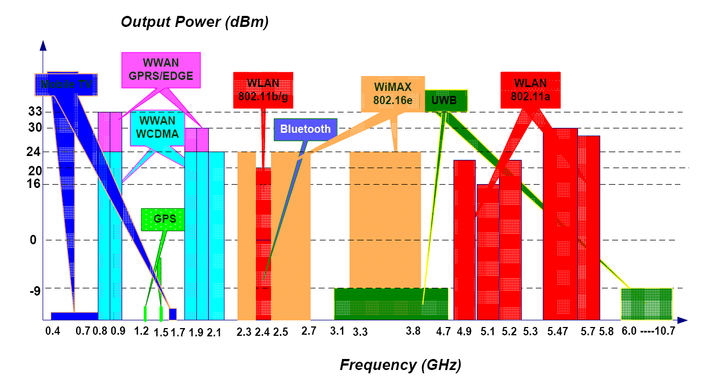Section: Overall Objectives
Introduction
The success of radio networking relies on a small set of rules: i) protocols are completely defined beforehand, ii) resource allocation policies are mainly designed in a static manner and iii) access network architectures are planned and controlled. Such a model obviously lacks adaptability and also suffers from a suboptimal behavior and performance.
Because of the growing demand for radio resources, several heterogeneous standards and technologies have been introduced by the standard organizations or industry by different workgroups within the IEEE (802 family), ETSI (GSM), 3GPP (3G, 4G) or the Internet Society (IETF standards) leading to the almost saturated usage of several frequency bands (see Fig. 1).
|
These two facts, obsolescence of current radio networking rules on one hand, and saturation of the radio frequency band on the other hand, are the main premises for the advent of a new era of radio networking that will be characterized by self-adaptive mechanisms. These mechanisms will rely on software radio technologies, distributed algorithms, end-to-end dynamic routing protocols and therefore require a cross-layer vision of “cognitive wireless networking”: Getting to the meet of Cognition and Cooperation, beyond the inherent communication aspects: cognition is more than cognitive radio and cooperation is not just relaying. Cognition and cooperation have truly the potential to break new ground for mobile communication systems and to offer new business models. [37]
From a social perspective, pervasive communications and ambient networking are becoming part of more and more facets of our daily life. Probably the most popular usage is mobile Internet access, which is made possible by numerous access technologies, e.g. cellular mobile networks, WiFi, Bluetooth, etc. The access technology itself is becoming transparent for the end user, who does not care about how to access the network but is only interested in the services available and in the quality of this service.
Beyond simple Internet access, many other applications and services are built on the basis of pervasive connectivity, for which the communication is just a mean, and not a finality. Thus, the wireless link is expected to even be invisible to the end user and constitutes the first element of the Future Internet of Things [36], to develop a complete twin virtual world fully connected to the real one.
The way radio technologies have been developed until now is far from offering a real wireless convergence [26]. The current development of the wireless industry is surely slowed down by the lack of radio resources and the lack of systems flexibility.
One can get rid of this technological bottleneck by solving three complementary problems: terminal flexibility, agile radio resource management and autonomous networking. These three objectives are subsumed by the concept of Software Radio, a term coined by J. Mitola in his seminal work during the early 90's [33], [34]. While implementing everything in software nodes is still an utopia, many architectures now hitting the market include some degree of programmability; this is called Software-Defined Radio. The word “defined” has been added to distinguish from the ideal software radio. A software defined radio is a software radio which is defined for a given frequency range and a maximal bandwidth.
In parallel, the development of new standards is threatened by the radio spectrum scarcity. As illustrated in Fig. 1, the increasing number of standards already causes partial saturation of the UHF band, and will probably lead to its full saturation in the long run. However, this saturation is only “virtual” because all equipments are fortunately not emitting all the time [26]. A good illustration is the so-called “white spaces”, i.e. frequency bands that are liberated by analog television disappearing and can be re-used for other purposes, different rules are set up in different countries. In this example, a solution for increasing the real capacity of the band originates from self-adaptive behavior. In this case, flexible terminals will have to implement agile algorithms to share the radio spectrum and to avoid interference. In this context, cooperative approaches are even more promising than simple resource sharing algorithms.
With Software-Defined Radio technology, terminal flexibility is at hand, many questions arise that are related to the software layer of a software radio machine: how will this kind of platform be programmed? How can we write programs that are portable from one terminal to another? Autonomous networking will only be reached after a deep understanding of network information theory. Thus, given that there will be many ways for transmitting data from one point to another, what is the most efficient way in terms of throughput? power consumption? etc. Last but not least, agile Radio Resource sharing is addressed by studying mimo and multi-standard radio front-end. This new technology is offering a wide range of research problems. These three topics: software programming of a software radio machine, distributed algorithms for radio resource management and multi-standard radio front-end constitute the research directions of Socrate.


